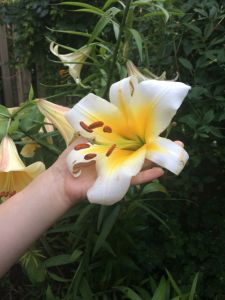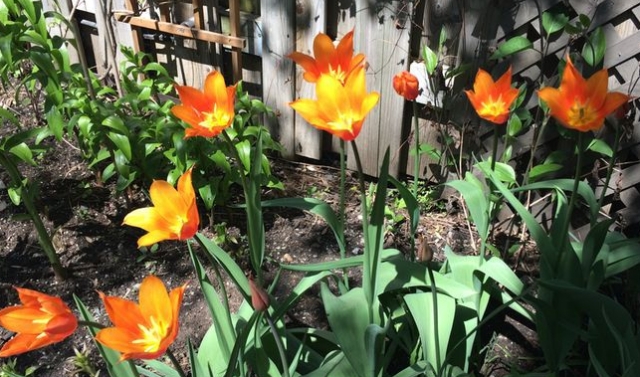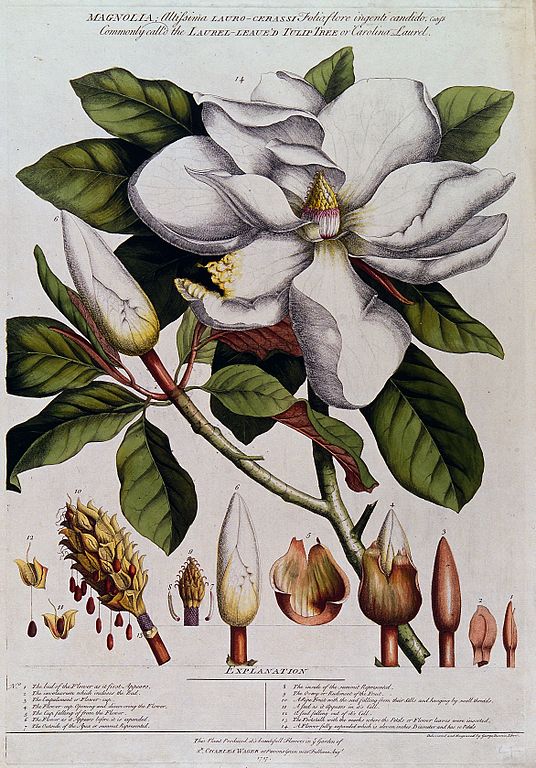
My sweet peas
The best part about being ill is the flowers. I received so many flowers from well-wishers after my surgery last winter and then for months afterwards, until the spring offered its own bounty outside the window. The flowers truly brightened my days, especially in the bleak hospital. I spent the hours I was alone there in the early morning gazing at their delicate forms, the tender pink and purple and brilliant yellow, the varying greens of the leaves. They brought me sweet joy in the midst of grief.
And then I spent much of the past summer, like every summer, enjoying the flowers outside. I have been especially blessed by the fragrant lilies in my tiny city garden: what a delight it was to discover them when I bought this house last year—I have counted about twenty-five gorgeous varieties, thanks to Joan, the previous owner and an amateur lily specialist. Now that it is autumn and flowers are scarce, I cherish the intricate seed heads the flowers have left behind on their stalks. They are stunning little miracles, each a beautiful design with its own ingenious seed-dispersion mechanism.

One of Joan’s huge, fragrant lily.
I deeply love flowers. I love them not just for their beauty, but also for what they have taught me about life. Flowers, so ephemeral, have long been a core image to my understanding of life and death. I study not only their budding and blooming, but their wilting and withering too. Their lives are so brief.
For many years I have had the great privilege of living in an old farmhouse at the edge of a small town in the country. (I raised my children there, but since Nathan started circus and I took a job in the city, I have kept it as my country home—a precious extravagance.) This place is my nature sanctuary. When I bought it in the last year of the last century, the grounds had been planted partly as a mourning garden, partly as a bird garden, by the previous owner, a woman named Claire whose son had died in a motorcycle accident. (My only published short story, Claire’s House, is about her and the haunted house and her garden of grief) She put in perennial beds, fussy ornamentals, weeping trees to weep under, and many fruiting shrubs and seeding trees like sumac to attract birds. The giant willow that fills the front yard and the row of elderly maples along the road date back to the house’s earliest days as a homestead when the rest of the land was laboriously wrestled from the forest for the planting of field crops. The woods are still trying to take that land back, creeping past the fence in the dark.
So lots of the flowers I get to enjoy are Claire’s, now long dead herself from cancer. She favoured rose bushes and peonies, irises, phlox, and especially lilacs. I love the lilacs too; they are first of the spring’s heady parade of perfumes, followed by the girlish honeysuckle, tiny lilies of the valley, heavy-headed peonies. Last are the intensely sweet mock orange by the front porch, where I spent many of the early summer days this year recovering from chemo treatments. In July and August I am especially grateful for the bee balm that the hummingbirds fight over so furiously. The pretty pink tea roses that line the drive bloom from June to November if I tend to them, though this year they have been ravaged by the also beautiful rose beetle. Last summer it was the rose chafers, and before that it was the rose borer. Not to mention invasive raspberries. And even before that it was Claire herself who boldly came to dig up shoots. A year after I’d moved in, I found her driving the spade into the ground with her red suede boot. She was not one to ask for permission, nor to apologise. Her grief was all over this garden, so she felt entitled to it. And who was I with my two living little boys to complain?

Garden gnome (me) and some of the phlox that Claire planted in the now overgrown garden. The mown lawn here is actually the overgrown driveway, which used to be gravel. And peeking out from under a blanket of grapevines is the overgrown shed that Claire stole from the barnyard.
Since acquiring the house, I have been purposefully re-wilding the acre or two left to it when the farmland along the road was sold off and sub-divided into housing lots for small bungalows. (Fortunately the fields in back with the old barn were not divided and remain a meadow, backed by woods.) I should be honest and admit that some of the re-wilding has been negligence: for years I was overwhelmed by single-parenting and going back to school and then getting an apartment in the city for work and not being able to get back to the house on weekends while my son was a teen and in trouble. Nature, like teenagers, can be very quick about taking advantage of a turned back, and the sumacs snuck in fast. I have been sad to see some of the more delicate perennials disappear under hardier, spreading plants that need a firmer gardener’s hand. But there have been gifts too.

This and most photos in this post by Roy, who loves yellow flowers. My flower photos are currently lost.
The wildflowers I love even more than the planted perennials. I adore the violets and forget-me-knots of spring, the tall and elegant Queen Anne’s Lace, the daisies and black-eyed Susans reminiscent of my childhood summers. There are countless other flowers blooming in my unweeded lawn and the unmown lower meadow. I don’t know all their names—they have been lost now in our grass-obsessed suburban culture. How wonderful this world would be if we cared enough for these wildflowers to recognise and name them all, even the tiniest! And to give them space to grow and feed the pollinating bees and butterflies! Instead we mow everything down to a deathly monoculture of dull, dull grass.

Overgrowing the patio.
But here, I am spoiled with flowers.
So what is the lesson they have taught me? Flowers blessed with perfect conditions –just the right amount of sun and rain, just the right type of soil, the right temperatures during day and night, thanks to where they are planted or where their seeds were sown– will put out an abundance of perfect blooms. Sometimes they flourish unmolested. Sometimes they are attacked by pests and become imperfect. Sometimes they disappear overnight, grazed upon by hungry groundhogs or deer. And sometimes, even with the right conditions, some of the blooms are nevertheless misshapen or stunted or never open. Other flowers struggle against all sorts of challenges just because of where they are rooted: too much sun or not enough, flooding rain or drought, competing plants and weeds, poor soil, trampling feet, lawn mowers. I’ve seen some flowers, determined to grow in the lawn, shortening their stems after repeated mowings so the flowers can duck their heads below the mower’s blades. In the long meadow, some will grow taller, struggling to reach high enough for precious sunlight and passing pollinators.

Some tulips celebrating the spring sunshine!
Each flower also has its own life expectancy. Some bloom only for one glorious day, others for several days, or, like orchids, even weeks. I’ve watched tulips hold their buds tight for weeks during a slow cold spring, waiting for steady sunshine before spreading their petals wide. Each flower, if left uncut to its life cycle, strives only to complete its reproductive mission. Once its pretty fragrance and colour and form have attracted its pollinators, the petals wither and drop while the secret work of gestation takes place with the seed head and fruit forming at the flower’s centre. Each then has its own fascinating strategy for spreading its seeds to hopefully fertile soil. And then it is done.

I have watched the life cycles of so many different flowers in my garden over the years. Sometimes it has been my careless step that has crushed the fragile petals. Sometimes it has been my scissors that have cut the stem, fating the flower to a decorative, infertile life in a vase. Sometimes I’ve tried to be a good gardener and pulled the flowering weeds—often just as pretty to my eye as their cultivated cousins. Still, I am distraught when the roadside flowers are mown down in the country. These days I can hardly bring myself to cut or pull anything; they all seem so precious.
Flowers have reinforced the lesson that life isn’t and never promised to be fair. For some it’s easy, for others it’s not. For some it brings abundance while others struggle with scarcity. Circumstances can change without warning. The easy life can suddenly be beset by hardship; adversity can be happily resolved. And while some live long, for others life is brief, but perhaps still glorious. It is all equally ordinary, equally marvelous. And always changeable.
I’m sad that the season for garden flowers is over now. I don’t want to go back indoors. And I’m ambivalent about going back to store-bought flowers, which are somehow never quite as wonderful as the wild ones, pretty though they are. But if I live past January, I know I will start to yearn for those delicate blooms and have to give in, perhaps with my favourite, a humble pot of crocuses.

Pingback: On Flowers — The Death Project – wandasncredible
Beautiful flowers, beautiful thoughts!
LikeLiked by 1 person
Great story and some beautiful flowers.
LikeLiked by 1 person
Am impressed at how you get to understand human lives through the cycles of flowers. It’s like you have accessed the soul of the universe through these particular flowers
It’s beautiful reading how you appreciate the world and life. Many don’t realize that life is a gift and you reminded me to be grateful for being alive
LikeLiked by 2 people
I love how you have painted the images here with your words, Susan.
LikeLiked by 2 people
Glorious indeed. I love the way you see the weave that holds us and the planet’s other inhabitants together. Always such a pleasure to read you and see the world through your kind eyes.💛💛
LikeLiked by 2 people
How beautiful to walk with you in this garden of great tenderness; to touch even at a distance this woman and her story; that a garden– aided by the words of a poet — can do this is one of the little miracles. Thank you, Susan!
LikeLiked by 2 people
Thank you for this lovely botanical life lesson. You’ve shown us how both beauty and meaning are uniquely represented in the transitory nature of flowers. Along with the solace and delight they provide come the seeds of faith in measureless futures. You remind us that flowers have a recursive ability to soften the harshness of existential questions over the vicissitudes of our lifespans, to give focus, to gently nudge us in a more transcendent direction.
Your words (like you) are a treasured inspiration, Susan.
LikeLiked by 1 person
Really lovely to read! I’m already looking forward to the spring and it’s lilacs 🤗
LikeLike
Pingback: Lessons Learned About Life, From Flowers | Olde Hippie
What an olfactory delight to read this.
LikeLike
You are a gift to this Earth, Susan.
LikeLike